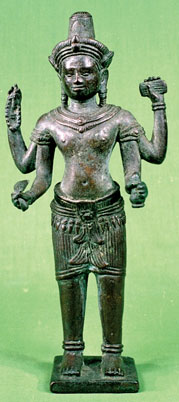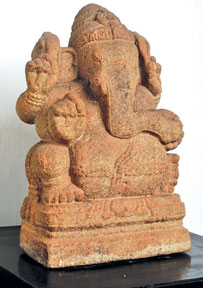Sri Lanka's sculptural influence on Bharatha Natyam
by Subashini Pathmanathan
 |
|
Lord Nataraja |
The oriental classical dances are mainly influenced by numerous
factors such as language, literature, culture, sculpture, religion,
paintings, vocal and instrumental music. All these have influenced the
classical Bharatha Natyam to a great extent.
The sculptures could be divided into different varieties. They are
made out of different metals such as copper, iron, brass, Iyempon a
combination of five different metals.
There are ivory sculptures, wooden made sculptures, granite stone
made sculptures, lime stone sculptures and clay sculptures. Sculptures
are the main source for the research study in oriental dance forms.
Bharatha Natyam is a Tamil classical dance form which is widely
practised and preserved in Sri Lanka. So, it is quite appropriate and
important to find out the close relationship between the sculptural
influences of Sri Lankan sculptures on Bharatha Natyam.
Generally, for research analysis it is necessary to trace the
coordination between these two different fine arts together. Islandwide
there are a variety of sculptures available. Most of the sculptures are
decorative sculptures which decorate the pillars, the roof tops of the
pillars, carved in the pillars and walls of the archaeological sites,
Hindu temple towers, temple walls, tunnel temples, art galleries and
ancient royal courts.
For Bharatha Natyam, the Chidambaram and Thanjavur temple sculptures
are the main productive source for dance research work. Similarly in
Odissi dance, the Kalinga sculptures are the main source for research.
The Hindu sculptures provide ample opportunities for researchers to
study the practical side of the Bharatha Natyam.
In Bharatha Natyam dancers try their best to imitate and adopt the
sculptural poses, sculptural body postures, body positions, foot stances
and positions, hand gestures and eye glances.
This helps researchers to conduct a comparative study of sculptures
with practical Bharatha Natyam. Most of the Bharatha Natyam dance poses
resemble the sculptural dance poses and the 108 Thandava Karanas of Lord
Siva.
All the sources have been derived from the ancient sculptural poses
especially from archaeological and ancient sources which are derived
guidelines from the ancient Hindu Agama Sastra and sutras. That's why
the Hindu deity sculptural poses all over the world must be the same.
The basic structures of the Hindu deities are the same, but the basic
style of the statues differs from place to place. If we analyse the
cause of the differences we will come to the conclusion that these
slight variations arise due to the local influences of the area where
that particular sculpture was made.
Sri Lanka's Hindu temple sculptures are almost the same as those
found in Indian temples. Yet to some extent they are being influenced by
the local traditions and regional influences. It could be observed by
the style of the structures. It is necessary that each temple deity, the
sculpture should be based on a certain defined philosophy.
 |
|
Lord Ganesh |
For instance, Lord Nataraja's statue all over Hindu areas and Hindu
temples in Tamil Nadu are almost the same. For instance, Lord Nataraja's
statue which was found in Polonnaruwa is quite different from the normal
Hindu Nataraja statues. This is due to the regional and cultural
influence of the area. This particular Lord Nataraja's statue implies
the Buddhist sculptural influence.
The ancient Siva Lingam structure found in Polonnaruwa is also
entirely different from the normal Shiva Lingam statues in Hindu
temples. The length of the Siva lingam is quite longer than that of the
normal Siva Lingam seen in the Santorum of Hindu temples. Even these
aerial, cultural and regional influences could be easily seen when we
compare the Sri Lankan ancient sculptural images with the same Indian
sculptures.
These differences could be seen in the One | could assume that this
is due to the cultural, regional and ideological influence on the
sculptor. In Hinduism some deities are in the standing position, and
others are in the sitting position. Each hand of the deity depicts
certain meaningful hand gestures.
If the dancer tries to depict the same sculptural pose in dance, the
dancer must adopt the same hand gestures of the selective idol.
So, the sculptures provide the main source for Bharatha Natyam which
is a Hindu religious dance form and it is necessary that we follow the
Hindu agama and Hindu Sasta traditions.
|

